Please note that this guide describes the colour genetics as they are in Horse Reality. We do our best to make the game as realistic as possible, however when new research is discovered it may be hard to implement this immediately seeing our existing system. In order to prevent misinformation, we try to annotate real genetic information that is conflicting with Horse Reality's genetics.
Welcome to the Colour Genetics Guide, which contains genetic knowledge important to Horse Reality explained from the basics to more advanced levels. Although it was meant to be quick, there still is a lot of text and knowledge to acquire - take your time, and please don't get discouraged because slowly understanding more and more genes is the key to success - even Rome wasn't built in a day. Please remember that we are always ready to answer any questions on the Horse Reality forum!
¶
Introduction
Before we start explaining genetics, we'll take you for a quick history tour. Below is a small dictionary, which helps with using genetic terms.
Long, long ago, all horses looked the same. They all were bay dun, with an E/E A/A D/D genotype. Then why can horses have so many different colours nowadays? When a new life begins, the genetic information of both parents gets combined. This process is far from perfect, so sometimes errors may occur: something gets lost, something changes, some parts get duplicated - many things can happen. These errors are called mutations. If they don't impact the development and health of a horse too negatively, they can be passed on to their offspring, and then their offspring passes it on to their offspring, and so the mutation gets spread around widely. Some mutations affect the colour of a horse, and that is how we ended up with every existing phenotype out there today. In nature, horses with fancy colours might not be able to survive because they need to be able to camouflage themselves well. However, since horses are domesticated there is no need for that anymore. Humans also often love unusual looks and will select for them, which is why we can now enjoy a variety of beautiful colours.
¶ Some Basic Definitions
Note: There are also hidden genes that cannot be tested, such as flaxen, and genes that have not yet been implemented in the game.
- Chromosome: A chromosome is a long DNA molecule that contains genetic information. Horses have 32 chromosome pairs or 64 chromosomes in total. They have two copies of each chromosome - one inherited from the dam, and one from the sire.
- Gene: A gene is a specific part of DNA that contains information for a certain protein/ function/…
- Locus: The place on the chromosomes where a specific gene is located. Plural loci.
- Alleles: These are different variants (mutations) of a gene. A horse inherits one allele from each parent. This means that for each gene, a horse has 2 alleles that together work towards the result - a horse's coat colour.
- Wild-type: The wild-type allele is the “standard” allele that naturally occurred first, in contrast to mutations, which are new variations.
- Dominant: A dominant allele (expressed by capital letters) needs only one copy to be expressed on a horse's coat colour unless it has special requirements that need to be met. A horse that has two copies of an allele (for example Z/Z) will look the same as a horse that only has one copy (Z/z). Many colour dilutions and white patterns are caused by dominant alleles.
- Recessive: A recessive allele (expressed by lowercase letters) only gets expressed when a horse has two copies of this allele (for example e/e). It will be suppressed if a dominant allele is present.
- Incomplete Dominant: The term incomplete dominant means that one allele is not fully dominant over the other; leading to an intermediate expression when one copy of the allele is present (for example CR/n) and a full expression when the horse has two copies of the allele (CR/CR).
- Heterozygous: A horse is heterozygous for a gene when it has two different alleles (for example CH/ch or G/g).
- Homozygous: A horse is homozygous for a gene when it has two copies of the same allele (for example CH/CH or g/g).
- Phenotype: A set of observable traits of an organism. In other words - what we see expressed as a horse's coat colour. The phenotype is determined by the genes of the horse, but also by environmental factors.
- Genotype: The full set of genetic information. It can also refer to one gene or a group of genes.
- Points: The mane, tail, lower legs, and ear rims of a horse.
- Foal camo: Foals are usually born with a paler colour than their adult coat will be. This is believed to be a form of camouflage. After shedding out, their adult colour will start appearing.
If a mutation is dominant (for example silver) and test results show a homozygous recessive genotype, this means that a horse doesn't have that mutation (z/z = no silver dilution). When a gene can have several different alleles (for example KIT), an n/n notation is usually used to represent that no mutations/alleles affecting the coat colour are present.
Note: It is incorrect to say that a horse has, for example, no cream gene, or no agouti or extension, when their genotype is n/n, a/a and so on. It is not possible to have a void instead of a working gene. Rather, we could refer to this as not having the cream allele, or being homozygous recessive for agouti.
¶ Base Colours
The base horse coat colours are caused by two genes working together - extension and agouti. Extension controls pigment production and agouti controls the distribution of black pigment, which results in three base colours: black, chestnut, and bay. In Horse Reality, bay can be differentiated into three shades: wild bay, bay, and seal brown. It is not yet known what causes the different shades of bay in the real life. Therefore, Horse Reality uses its own unique system, based on former scientific theories. It's important to note that base colours are completely independent of dilutions, modifiers and white patterns.
Summary: We differentiate 3 base colours: bay (wild bay, bay, seal brown), black and chestnut. Extension and agouti work together to create base colours.
¶ Extension
The extension (alleles: E, e) gene codes the ability to produce two pigments - eumelanin (black) and pheomelanin (red/yellow). Pigments are produced by special cells located mostly in the skin; melanocytes. When a certain receptor on the surface of a melanocyte is activated by hormones, it causes the production of black pigment. If the receptor is not activated, melanocytes produce red pigment by default.
The dominant E-allele is the wild-type allele, which means that all horses' ancestors had an E/E genotype. It codes for "normal" melanocytes, which can produce both pigments, black and red.
The recessive e-allele causes melanocytes to have inactive receptors, which completely disables the production of black pigment.
Summary: The E-allele gives the ability to produce both black and red pigment, whereas the e-allele leads to red pigment only.
¶ Agouti
The agouti (alleles: A, a) gene controls the distribution of black pigmentation - the dominant allele A (and other dominant variants present in Horse Reality) blocks the receptor with a special protein in some body parts, which prevents melanocytes from producing black pigment and results in red colour production. The black pigment gets restricted to the points of the horse. The recessive a-allele causes the receptors on pigment cells not to get blocked, so they are able to produce black pigment on the entire body.
In Horse Reality, the agouti gene can have four different alleles:
- A+ - Wild bay allele, dominant
- A - Bay allele, dominant
- At - Seal brown allele, dominant
- a - Recessive
Note: even though we call these alleles bay etc., they do not produce a bay phenotype by themselves. To determine the base colour of a horse, we also have to consider the extension status.
The wild bay (A+) and seal brown (At) alleles are hidden and not testable, meaning that their test results will just be displayed as A. This is because their existence has not been proven in real life. The order of dominance between the 4 agouti alleles is A+ > A > At > a, which means that if a horse is heterozygous, the allele of higher dominance gets expressed (assuming there is at least one dominant extension allele E present). The table below shows all possible combinations of the alleles with their outcome.
|
|
A+ |
A |
At |
a |
|
A+ |
A+/A+ Wild bay |
A+/A Wild bay |
A+/At Wild bay |
A+/a Wild bay |
|
A |
A/A+ Wild bay |
A/A Bay |
A/At Bay |
A/a Bay |
|
At |
A+/At Wild bay |
A/At Bay |
At/At Seal brown |
At/a Seal brown |
|
a |
A+/a Wild bay |
A/a Bay |
At/a Seal brown |
a/a Black |
Summary: The A-allele switches off black pigment on the body while allowing black points; whereas the a-allele allows black pigment on the whole body. There are 4 alleles of agouti: A+ (wild bay), A (bay), At (seal brown), a (recessive).
¶ Base Colours
Black (E/_ a/a) is caused by at least one dominant extension allele and homozygous recessive agouti. The E-allele allows the production of black pigment and a/a allows it to be expressed on the entire body. Some black horses will “sun bleach” which can be a result of exposure to sunlight, sweat etc., but possibly also genetic or dietary factors. This is often referred to as sun-faded black and gives their coat a lighter appearance.
Chestnut (e/e __) is caused by a homozygous recessive extension. Agouti status does not matter for chestnut-based horses, since there is no black pigment it can control (however, agouti status can be important when passing down alleles to offspring and determining their colours). Chestnut horses can come in a variety of shades - they can be very light with a shade close to a palomino or be a dark liver chestnut. Other terms used for chestnut are red or sorrel, often depending on the shade and/or region.
| Black and Chestnut base - Arabian Horse | |

(E/_ a/a) |
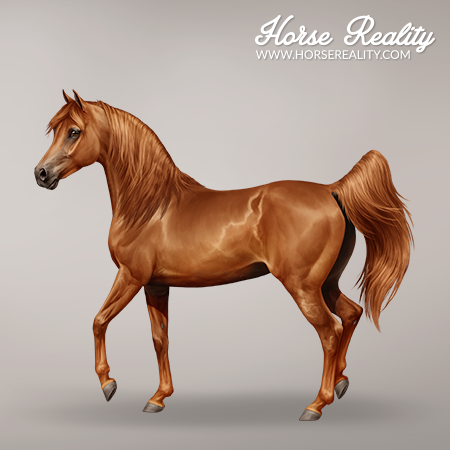
(e/e _/_) |
Bay (E/_ A/_) is caused by at least 1 dominant extension allele and 1 dominant agouti allele. The E-allele allows the production of black pigment, but the dominant agouti allele A restricts it to the points of the horse, resulting in a red body with black points: the bay phenotype. They can have many different shades:
- Wild bay (E/_ A+/_) is a lighter shade of bay. It can be distinguished from a “regular" bay by the low black points - instead of visible black legs, the black pigment barely reaches the pasterns. Often the coat, mane and tail are also lighter.
- Bay (E/_ A/A, A/At or A/a) horses have black points on their legs that go up to their knees and hocks. They have a reddish coat, shade variations are sometimes called blood bay.
- Seal brown (E/_ At/At or At/a) is a dark variation of bay. Seal-brown horses can sometimes be so dark that they resemble black horses. However, the soft parts of their body (muzzle, eyes, flanks, inside upper parts of legs) remain tan, red, or even yellow.
| Bay base variations - Arabian Horse | ||
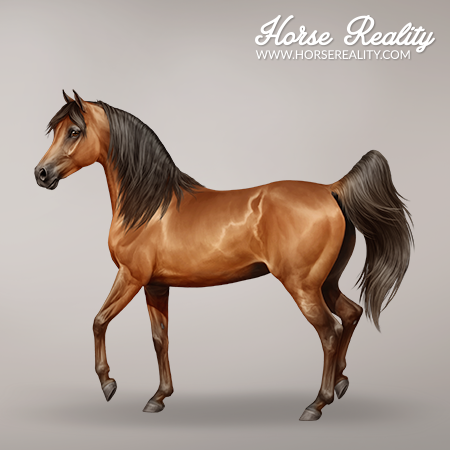
(E/_ A+/_) |

(E/_ A/_) |

(E/_ At/_) |
Working with these three base colours, we can add modifiers, dilutions and white patterns/markings to get the final colour!
¶ Modifiers
Mutations that don't dilute the colour of a horse but rather modify it in a specific way are called modifiers. Most modifiers cannot be tested at the moment, so they are often the reason why horses that have the same genetic test results may look different.
¶ Grey
Greying (G) is a progressive loss of colour caused by a dominant allele G. The grey allele can act on any colour. Grey horses are born with the colour coded by their genes, but the foal's coat usually shows hyperpigmentation. This means that their coat colour will be darker and much more saturated than normal. Grey foals also don't show typical foal camouflage. Grey hairs that sometimes show around the eyes of foals are called grey goggles.
In real life, a horse will gradually lose pigment over time. In Horse Reality, however, once a foal turns into an adult its coat changes to a randomly chosen adult grey phenotype. Possible phenotypes include early stages of the natural greying process seen in horses, like dark dapple grey, but also final stages: a completely “white” or a fleabitten coat. Sometimes grey horses may retain a non-grey area on their body, called a bloody shoulder. Despite the name, it can appear on any part of the body. If a horse with other white patterns or markings gets a darker shade of grey phenotype, its white patches may still show through it.
The test for grey in Horse Reality can be found in the COLOURS & MODIFIERS tab. Test results for a grey horse are G/G or G/g.
| Grey modifier - Akhal-Teke Horse and Arabian Horse | |||

|

|

|

|
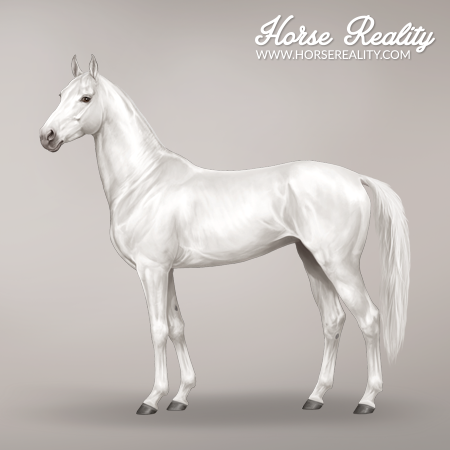
|
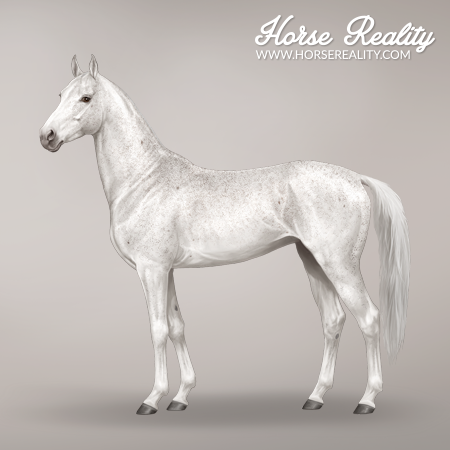
|

|
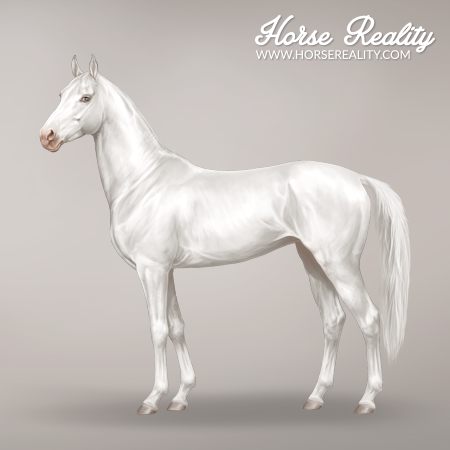
|
Summary: Grey (G) is a dominant allele causing progressive whitening of the whole body. Foals are born hyperpigmentated and often show grey goggles. Adult grey phenotypes are chosen randomly from breed's pool.
¶ Flaxen
Flaxen (f or fl) is a recessive allele of a hidden gene that only affects chestnut-based coats; turning the mane and tail into a yellow, cream or even white colour. Chestnut-based horses that have an F/f genotype are said to carry flaxen since they would need two copies (f/f) for it to show on their coat. Black and bay-based horses can only carry flaxen, even if they have an f/f genotype. Flaxen may not be visible on already diluted coats (for example palomino).
| Flaxen modifier - Mustang Horse |

|
Note: in real life, the genetic cause of flaxen manes and tails is unknown. It is suspected that flaxen could be a polygenic trait, controlled by more than one gene.
Summary: Flaxen (f, fl) is a hidden recessive allele that needs 2 copies to be visible. It lightens the manes and tail of chestnut-based colours.
¶ Sooty
Sooty (STY or sty), sometimes called smutty, is an allele of a hidden gene. The dominance is unknown and may differ between breeds or even different base colours. Sooty darkens a horse's coat in a variety of ways - there are no clear rules.
On chestnut-based horses, it often mostly darkens the legs, or lower body, or changes the entire coat colour from red to a shade of brown. This is often named liver chestnut. On bay-based horses, sooty is expressed mostly over the topline and upper part of the body. In extreme cases, sooty bays may be mistaken for seal browns. Sooty does not affect black-based coats.
The darkening of the coat caused by sooty usually increases with age. In Horse Reality, foals are born with the colour determined by their genes and will receive a sooty coat when they turn into an adult.
| Sooty modifier - Arabian Horse | ||
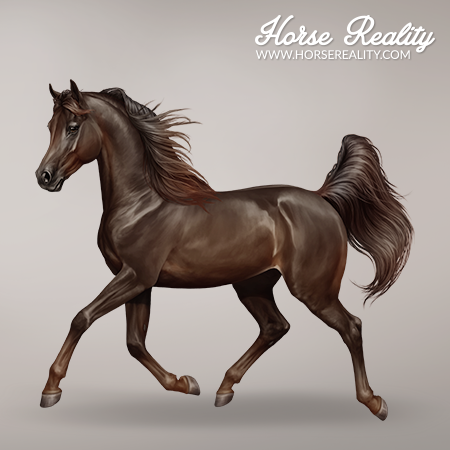
|

|
|
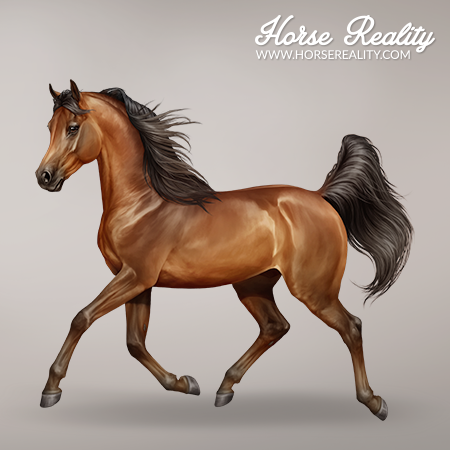
|

|

|
Summary: Sooty (STY or sty) is a hidden allele of unknown dominance, which darkens chestnut and bay-based coats in a variety of ways.
¶ Pangaré
Pangaré (PNG, PANG or PA), also called mealy, is a dominant allele of a hidden gene that turns the soft parts of a horse's body (lower belly, flanks, behind the elbows, inside of the legs, on the muzzle, and over the eyes) into lighter colours. The mealy effect is suspected to be a camouflaging technique. Pangaré only affects chestnut and bay-based coats and does not show on black bases and sometimes seal brown-based horses, and may not be expressed when other hidden alleles are present.
| Pangaré modifier - Brumby Horse | ||

|

|

|
Summary: Pangaré (PNG, PANG or PA) is a hidden dominant allele. It turns the soft parts of chestnut and bay-based horses' bodies into lighter colours.
¶ Dilutions
Dilutions are a group of mutations that lighten pigments produced in a horse's body. The outcome is significantly different from base colours and as such, diluted coats have unique names. Before going further we encourage you to repeat recognising base coat colours as they are crucial when it comes to naming diluted colours.
¶ Cream
Cream (CR) is an incomplete dominant allele, so a horse will look different depending on whether it has one or two copies of cream. Heterozygous cream (CR/n) dilutes red pigment to a tan, gold, yellow or even white colour, but the black pigment is little to not diluted at all. Homozygous cream (CR/CR) dilutes both red and black pigments to a very pale creamy colour, from slightly golden to almost “white”, with pink skin and blue eyes - hence the name of the mutation.
Note: Cream shares its locus with pearl, therefore a horse cannot be both homozygous for cream and homozygous for pearl at the same time.
The test for cream in Horse Reality can be found in the DILUTIONS tab under the “creampearl” gene. Test results for a cream horse are CR/n or CR/CR.
¶ Heterozygous Cream Dilutions
- Palomino (e/e CR/n) is a chestnut-based horse diluted by a single copy of cream. The body has a golden colour, mane and tail are even lighter, closer to white.
- Buckskin (E/_ A/_ CR/n) is a result of a bay base diluted by one cream allele. Buckskins' bodies get diluted to a tan/yellow/golden shade, but the black points are very slightly or not diluted. Wild bay and seal brown with one copy of cream are called wild buckskin and brown buckskin respectively. Their phenotypes depend on how much black pigment is present on the coat - Brown buckskins will look darker.
- Smoky black (E/_ a/a CR/n), a black base with a single cream allele, is not distinguishable from a black horse just by appearance. It is still debated if single cream can dilute black pigment slightly or cannot do it at all. Phenotypes often overlap, a smoky black can look jet black while a black horse can be sun-faded, so the best way to be sure if your horse is a smoky black indeed is by doing a genetic test.
| Cream dilution (CR/n) - Pura Raza Española | ||

(e/e CR/n) |
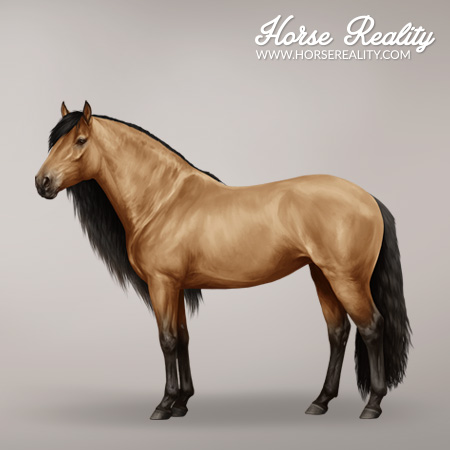
(E/_ A/_ CR/n) |

(E/_ a/a CR/n) |
¶ Homozygous Cream Dilutions
All homozygous cream dilutions have overlapping phenotypes and cannot be told apart just by their appearance. However, their names do depend on the base colour.
- Cremello (e/e CR/CR) is chestnut-based.
- Perlino (E/_ A/_ CR/CR) is bay-based. The other bay variations can be named wild perlino and brown perlino to emphasise a particular genotype.
- Smoky cream (E/_ a/a CR/CR) is black-based.
| Cream dilution (CR/CR) - Pura Raza Española | ||

(e/e CR/CR) |
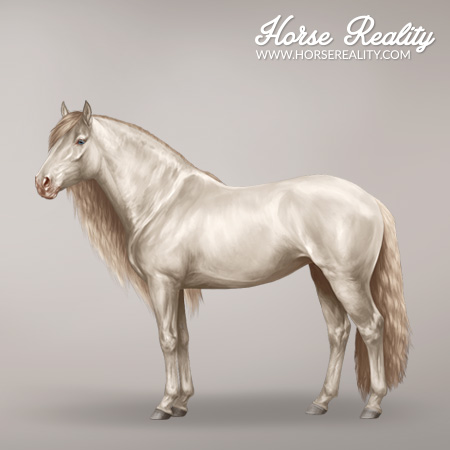
(E/_ A/_CR/CR) |

(E/_ a/a CR/CR) |
Summary: Cream (CR) is an incomplete dominant mutation, the outcome depends on whether one or two copies are present. Cream colours are named according to the base colours. Cream shares a locus with pearl.
¶ Pearl
Pearl (prl) is a recessive mutation located at the same locus as cream. It dilutes red and black pigment only when homozygous (prl/prl) is present or when it is paired with a Cream allele (CR/prl). Homozygous pearl (prl/prl) dilutes red pigment to gold, and black to tan or light brown, which resembles the champagne dilution. Additionally, the skin has a mottled pink to light brown colour, eyes are diluted to an amber or tan shade. Pearl paired with cream creates horses more similar to a homozygous cream phenotype. Heterozygous genotype prl/n indicates only a pearl carrier.
- Chestnut pearl (e/e prl/prl) - chestnut-based pearl results in a uniformly golden horse.
- Bay pearl (E/_ A/_ prl/prl) horses have golden bodies with tan or light brown manes, tails, and feathers (if a horse has feathers).
- Black pearl (E/_ a/a prl/prl) characteristics are tan or light brown body with slightly darker long hairs (mane, tail and optionally feathers).
The test for pearl in Horse Reality can be found in the DILUTIONS tab under the “creampearl” gene.
| Pearl dilution - Irish Cob Horse | ||

(e/e prl/prl) |

(E/_ A/_ prl/prl) |

(E/_ a/a prl/prl) |
Pearl and cream combinations are called
- Palomino pearl (e/e CR/prl) on a chestnut base.
- Buckskin pearl (E/_ A/_ CR/prl) on a bay base.
- Smoky black pearl (E/_ a/a CR/prl) on a black base.
Their colour is much lighter than that of homozygous pearl horses; more similar to a homozygous cream phenotype.
| Cream Pearl - Irish Cob Horse | ||

(e/e CR/prl) |
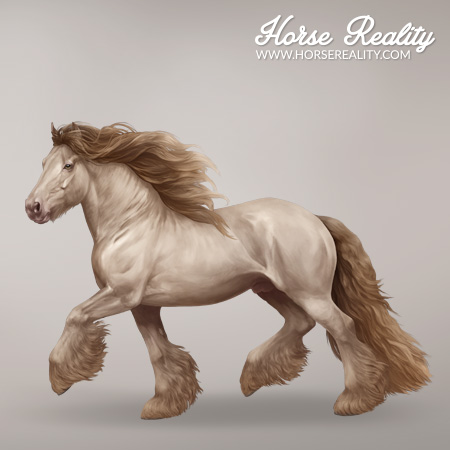
(E/_ A/_ CR/prl) |

(E/_ a/a CR/prl) |
Summary: Pearl (prl) is a recessive mutation sharing its locus with cream. Pearl colours are named accordingly to base colours. There is a possibility of carrying pearl in case of prl/n genotype.
¶ Dun
Dun (D) is a dominant allele of a gene that has the same name. The Dun locus has 2 other possible alleles: nd1 and nd2, both recessive to D, but they are not diluting alleles. Dun dilutes all pigments and creates primitive markings, such as a dorsal (back) stripe going through a tail, leg bars, transverse (shoulder) and neck stripes, ear bars, a dark face mask, and frosting (much lighter hair strands in the mane and top of the tail). The number and intensity of present primitive markings can differ between horses and/or breeds. The best known for exceptionally rich frosting and other dun traits are Fjord Horses.
Depending on the base colour, dun coats are called:
- Red dun (e/e D/_), on a chestnut base.
- Bay dun (E/_ A/_ D/_), on bay base. Dun on wild bay and seal brown can be called wild bay dun and seal, brown or sable dun respectively.
- Black dun (E/_ a/a D/_), on a black base, also known as grulla or grullo. Grulla means “crane” in Spanish.
| Dun dilution - Irish Cob Horse | |||

(e/e D/_) |
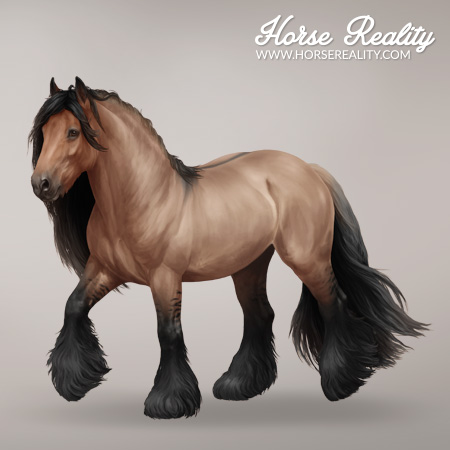
(E/_ A/_ D/_) |

(E/_ A/_ D/_) |
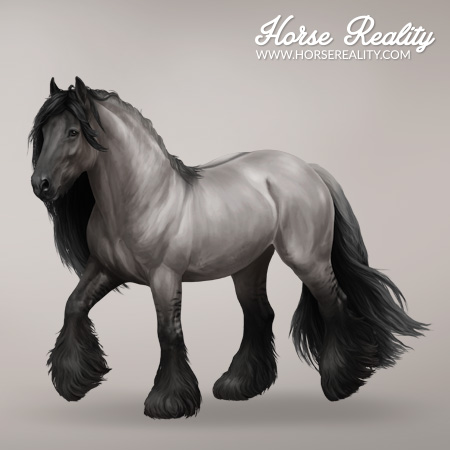
(E/_ a/a D/_) |
- Non-dun 1 (nd1) is a mutation on the dun gene. It is recessive to D but dominant over nd2. When expressed, it creates primitive markings such as a dorsal stripe, but it lacks the typical dun dilution. It is suspected to enhance (sun)fading.
- Non-dun 2 (nd2) is another mutation of dun, recessive to all other alleles (D, nd1). It does not affect the phenotype and causes neither primitive markings nor a dilution of the coat.
| Non-Dun1 - Namib Desert Horse | ||
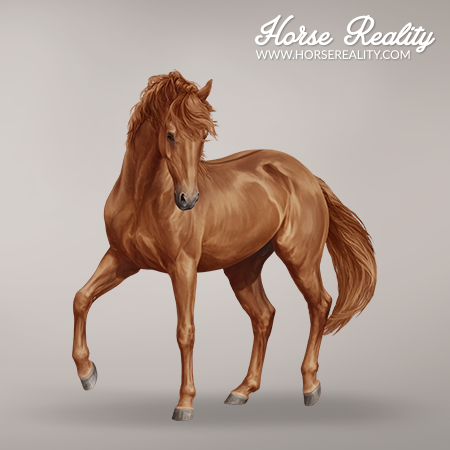
|
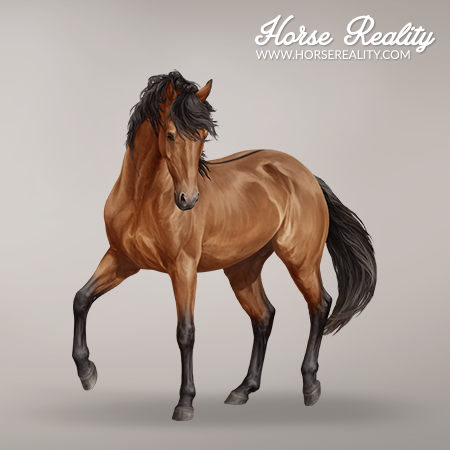
|
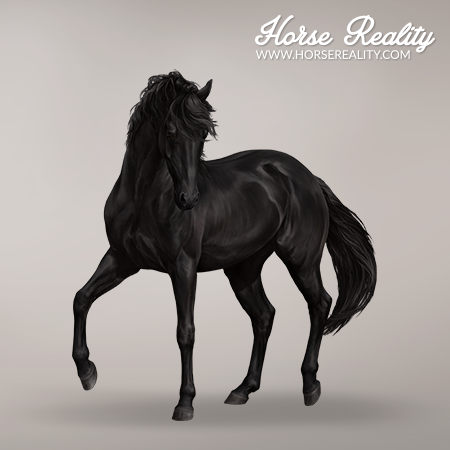
|
Dominance in the dun gene: D > nd1 > nd2. A table with possible genotypes and their results is below.
| D | nd1 | nd2 | |
|---|---|---|---|
| D |
D/D Dun |
D/nd1 Dun |
D/nd2 Dun |
| nd1 |
nd1/D Dun |
nd1/nd1 primitives |
nd1/nd2 primitives |
| nd2 |
nd2/D Dun |
nd2/nd1 primitives |
nd2/nd2 no effect |
The tests for dun and nd1 in Horse Reality can be found in the DILUTIONS tab.
Summary: Dun (D) is a dominant allele that dilutes body and creates primitive markings. The recessive nd1 allele causes primitive markings only.
¶ Champagne
Champagne (CH) is a dominant mutation that dilutes red pigment to gold, and black pigment to a pale brownish colour with a unique lilac tint. All champagne horses have light, pinkish or light brown, mottled skin and amber or hazel eyes. Foals are born much darker with blueish eyes, when growing up their coat quickly lightens and their eyes darken. Champagne sometimes creates a beautiful coat sheen. Even though the colours that champagne creates are more similar to pearl, they are much more often mistaken for heterozygous cream coats.
- Gold champagne (e/e CH/_) is chestnut-based and can easily be mistaken for a palomino, with a golden body and lighter mane and tail. The difference that is the easiest to spot is the pink, mottled skin typical for champagne horses.
- Amber champagne (E/_ A/_ CH/_) horses have tan bodies, light brown manes and tails, and pink freckled skin. Champagne on a seal brown base is called sable champagne.
- Classic champagne (E/_ a/a CH/_) has a hard-to-describe pale brown colour, with a tint often described as lilac, and darker points.
The test for champagne in Horse Reality can be found in the DILUTIONS tab.
| Champagne dilution - Quarter Horse | ||

(e/e CH/_) |
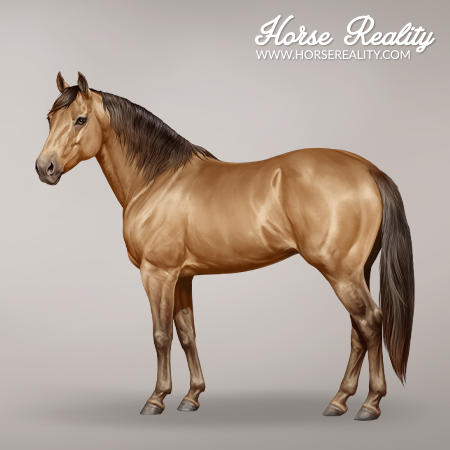
(E/_ A/_ CH/_) |
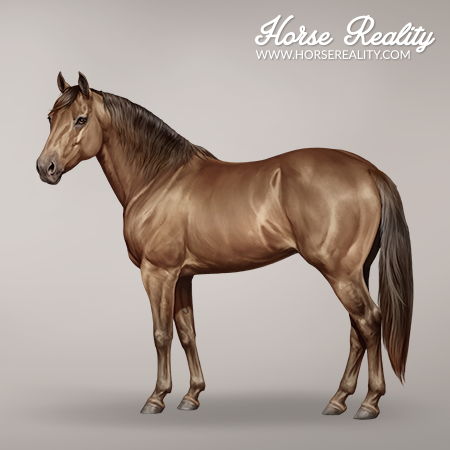
(E/_ a/a CH/_) |
Summary: Champagne (CH) is a dominant mutation that dilutes both red and black pigment. Champagne horses have mottled skin and amber coloured eyes.
¶ Silver
Silver (Z), also called silver dapple or taffy, is a dominant mutation that dilutes black pigment only, which means that chestnut-based horses can only carry it. The long hairs (mane, tail, feathering) get diluted to a nearly white colour. The black body can be undiluted, lightened very little, or have a rich brown colour. Silver black phenotypes are famous for the beautiful dapples on their coat and although they are common, they are not always present. Silver foals often have light eyelashes and coarse muzzle and facial hairs, but this rule also has its exceptions. Silver phenotypes are often misidentified as chestnut-based colours.
Silver bay (E/_ A/_ Z/_) horses have pale manes and tails, diluted black points and unchanged body colour. If a horse is a silver seal brown, it may have a slightly diluted body, like silver black horses sometimes do.
Silver black (E/_ a/a Z/_) horses have pale manes and tails. The coat commonly has impressively expressed dapples. Some silver blacks have only a blue tint or have completely unchanged body colour.
The test for silver in Horse Reality can be found in the DILUTIONS tab.
| Silver dilution - Finnhorse | ||
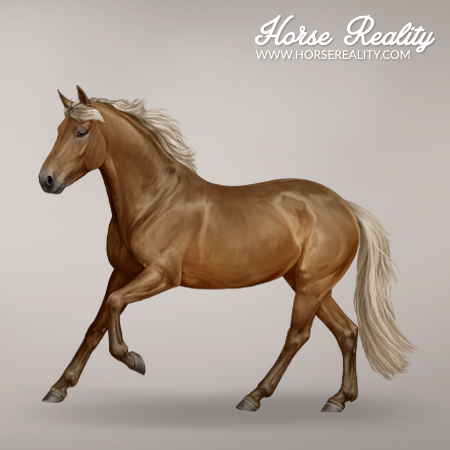
(E/_ A/_ Z/_) |
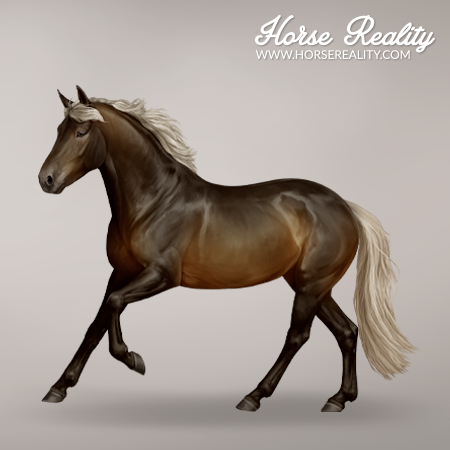
(E/_ A/_ Z/_) |

(E/_ a/a Z/_) |
Summary: Silver (Z) is a dominant mutation that dilutes black pigment. Points (especially long hair) are diluted more than the body.
¶ Mushroom
Mushroom (mu) is a recessive dilution that affects red pigment, which means it affects chestnut and bay-based horses only. It dilutes the coat to a “sepia” toned colour, often accompanied by a lighter mane and tail.
- Chestnut mushroom (e/e mu/mu) horses have a distinctive sepia-toned colour, often with a lighter “flaxen” mane and tail.
- Bay mushroom (E/_ A/_ mu/mu) coats lack the reddish hue of a typical bay, with countershading on the top line (darker head, neck, shoulders).
The test for mushroom in Horse Reality can be found in the DILUTIONS tab.
| Mushroom dilution - Shetland Pony | |

|

|
Summary: Mushroom (mu) is a recessive mutation that dilutes red pigment. Mushroom horses have a sepia-toned coat.
¶ Combinations of Dilutions
Horses can have multiple of the above-mentioned dilutions at the same time. Every combination of different dilutions has a corresponding name according to the base colour and all dilutions involved. Lists of these names can be found below, grouped by base colours.
¶ Chestnut-based dilutions
Chesnut-based horses can only carry silver dilution, so it is not included in the list. For every chestnut-based horse with Z/z or Z/Z genotype “carrying silver” can be added to the name.
| Cream/Pearl | Dun | Champagne | Outcome |
|---|---|---|---|
| CR/n | nd2/nd2 | ch/ch | Palomino |
| CR/n | D | ch/ch | Dunalino/ Palomino Dun |
| CR/n | nd2/nd2 | CH | Gold Cream |
| CR/n | D | CH | Gold Cream Dun |
| CR/CR | nd2/nd2 | ch/ch | Cremello |
| CR/CR | D | ch/ch | Cremello Dun |
| CR/CR | nd2/nd2 | CH | Cremello Champagne |
| CR/CR | D | CH | Cremello Champagne Dun |
| CR/prl | nd2/nd2 | ch/ch | Palomino Pearl |
| CR/prl | D | ch/ch | Dunalino Pearl |
| CR/prl | nd2/nd2 | CH | Gold Cream Pearl |
| CR/prl | D | CH | Gold Cream Pearl Dun |
| prl/prl | nd2/nd2 | ch/ch | Chestnut Pearl |
| prl/prl | D | ch/ch | Chestnut Pearl Dun |
| prl/prl | nd2/nd2 | CH | Gold Pearl |
| prl/prl | D | CH | Gold Pearl Dun |
| n/n | D | ch/ch | Chestnut Dun |
| n/n | nd2/nd2 | CH | Gold Champagne |
| n/n | D | CH | Gold Champagne Dun |
¶ Bay-based dilutions
Below is a list of bay-based diluted coat names. For seal brown bases a “brown” segment is added to them, and for wild bay bases “wild”. E.g. Brown buckskin, wild buckskin. Champagne colours on seal brown base are called sable instead of amber.
| Cream/Pearl | Dun | Champagne | Silver | Outcome |
|---|---|---|---|---|
| CR/n | nd2/nd2 | ch/ch | z/z | Buckskin |
| CR/n | D | ch/ch | z/z | Dunskin/ Buckskin Dun |
| CR/n | nd2/nd2 | CH | z/z | Amber Cream |
| CR/n | nd2/nd2 | ch/ch | Z | Silver Buckskin |
| CR/n | D | CH | z/z | Amber Cream Dun |
| CR/n | D | ch/ch | Z | Silver Dunskin |
| CR/n | nd2/nd2 | CH | Z | Amber Silver Cream |
| CR/n | D | CH | Z | Amber Silver Cream Dun |
| CR/CR | nd2/nd2 | ch/ch | z/z | Perlino |
| CR/CR | D | ch/ch | z/z | Perlino Dun |
| CR/CR | nd2/nd2 | CH | z/z | Perlino Champagne |
| CR/CR | nd2/nd2 | ch/ch | Z | Silver Perlino |
| CR/CR | D | CH | z/z | Perlino Champagne Dun |
| CR/CR | D | ch/ch | Z | Silver Perlino Dun |
| CR/CR | nd2/nd2 | CH | Z | Silver Perlino Champagne |
| CR/CR | D | CH | Z | Silver Perlino Champagne Dun |
| CR/prl | nd2/nd2 | ch/ch | z/z | Buckskin Pearl |
| CR/prl | D | ch/ch | z/z | Dunskin Pearl |
| CR/prl | nd2/nd2 | CH | z/z | Amber Cream Pearl |
| CR/prl | nd2/nd2 | ch/ch | Z | Silver Buckskin Pearl |
| CR/prl | D | CH | z/z | Amber Cream Pearl Dun |
| CR/prl | D | ch/ch | Z | Silver Dunskin Pearl |
| CR/prl | nd2/nd2 | CH | Z | Amber Silver Cream Pearl |
| CR/prl | D | CH | Z | Amber Silver Cream Pearl Dun |
| prl/prl | nd2/nd2 | ch/ch | z/z | Bay Pearl |
| prl/prl | D | ch/ch | z/z | Bay Pearl Dun |
| prl/prl | nd2/nd2 | CH | z/z | Amber Pearl |
| prl/prl | nd2/nd2 | ch/ch | Z | Silver Bay Pearl |
| prl/prl | D | CH | z/z | Amber Pearl Dun |
| prl/prl | D | ch/ch | Z | Silver Bay Pearl Dun |
| prl/prl | nd2/nd2 | CH | Z | Amber Silver Pearl |
| prl/prl | D | CH | Z | Amber Silver Pearl Dun |
| n/n | D | ch/ch | z/z | Bay Dun |
| n/n | D | CH | z/z | Amber Dun |
| n/n | D | ch/ch | Z | Silver Bay Dun |
| n/n | D | CH | Z | Amber Silver Dun |
| n/n | nd2/nd2 | CH | z/z | Amber Champagne |
| n/n | nd2/nd2 | CH | Z | Amber Silver |
| n/n | nd2/nd2 | ch/ch | Z | Silver Bay |
¶ Black-based dilutions
Here, a list of black-based diluted coat names can be found.
| Cream/Pearl | Dun | Champagne | Silver | Outcome |
|---|---|---|---|---|
| CR/n | nd2/nd2 | ch/ch | z/z | Smoky Black |
| CR/n | D | ch/ch | z/z | Smoky Black Dun |
| CR/n | nd2/nd2 | CH | z/z | Classic Cream |
| CR/n | nd2/nd2 | ch/ch | Z | Silver Smoky Black |
| CR/n | D | CH | z/z | Classic Cream Dun |
| CR/n | D | ch/ch | Z | Silver Smoky Black Dun |
| CR/n | nd2/nd2 | CH | Z | Classic Silver Cream |
| CR/n | D | CH | Z | Classic Silver Cream Dun |
| CR/CR | nd2/nd2 | ch/ch | z/z | Smoky Cream |
| CR/CR | D | ch/ch | z/z | Smoky Cream Dun |
| CR/CR | nd2/nd2 | CH | z/z | Smoky Cream Champagne |
| CR/CR | nd2/nd2 | ch/ch | Z | Silver Smoky Cream |
| CR/CR | D | CH | z/z | Smoky Cream Champagne Dun |
| CR/CR | D | ch/ch | Z | Silver Smoky Cream Dun |
| CR/CR | nd2/nd2 | CH | Z | Silver Smoky Cream Champagne |
| CR/CR | D | CH | Z | Silver Smoky Cream Champagne Dun |
| CR/prl | nd2/nd2 | ch/ch | z/z | Smoky Black Pearl |
| CR/prl | D | ch/ch | z/z | Smoky Black Pearl Dun |
| CR/prl | nd2/nd2 | CH | z/z | Classic Cream Pearl |
| CR/prl | nd2/nd2 | ch/ch | Z | Silver Smoky Black Pearl |
| CR/prl | D | CH | z/z | Classic Cream Pearl Dun |
| CR/prl | D | ch/ch | Z | Silver Smoky Black Pearl Dun |
| CR/prl | nd2/nd2 | CH | Z | Classic Silver Cream Pearl |
| CR/prl | D | CH | Z | Classic Silver Cream Pearl Dun |
| prl/prl | nd2/nd2 | ch/ch | z/z | Black Pearl |
| prl/prl | D | ch/ch | z/z | Black Pearl Dun |
| prl/prl | nd2/nd2 | CH | z/z | Classic Pearl |
| prl/prl | nd2/nd2 | ch/ch | Z | Silver Black Pearl |
| prl/prl | D | CH | z/z | Classic Pearl Dun |
| prl/prl | D | ch/ch | Z | Silver Black Pearl Dun |
| prl/prl | nd2/nd2 | CH | Z | Classic Silver Pearl |
| prl/prl | D | CH | Z | Classic Silver Pearl Dun |
| n/n | D | ch/ch | z/z | Black Dun |
| n/n | nd2/nd2 | CH | z/z | Classic Champagne |
| n/n | nd2/nd2 | ch/ch | Z | Silver Black |
| n/n | D | CH | z/z | Classic Dun |
| n/n | D | ch/ch | Z | Silver Black Dun |
| n/n | nd2/nd2 | CH | Z | Classic Silver Champagne |
| n/n | D | CH | Z | Classic Silver Dun |
¶ White Patterns
White patterns can appear over any coat colour. They can range from just a few white hairs on the body, to almost completely covering the colour determined by base colour, modifiers, and dilutions. When naming coat colours, names of white patterns are added usually at the end.
¶ Frame Overo
Frame overo (OLW) can be characterised by white patches on the body and head with a horizontal orientation. The white areas typically don't cross over the back and the legs of the horse, making it seem like the white is “framed” by colour when looking at the horse from the side. The edges of the white patches are defined, sharp and have a more jagged shape. Horses with frame overo commonly have a blaze that is wider on the forehead. A coloured upper lip on an otherwise very white head is also possible. They may have 1 or 2 blue eyes.
The pattern is extremely variable in expression. Horses may have no white at all, or just a single blue eye. Minimal expressions may lead to head markings without any white patches on the body. Horses with a louder expression may have some white patches on their belly and/or neck. The white patches may also cover almost the entire side of the horse, all the way from the neck to the hindquarters.
The OLW-allele is incomplete dominant, but lethal when homozygous, resulting in the Overo Lethal White Syndrome (OLWS). Horses with one copy of OLW are completely healthy, but foals born with 2 copies of OLW (OLW/OLW) have an underdeveloped intestinal tract. This leads to death within a couple of days. There is no cure, and foals born with the OLWS will therefore be humanely euthanised right after birth. In-game, you will receive a notification when a foal is born with OLWS, which mentions that the foal had to be humanely put to sleep. When 2 horses that both have a copy of OLW are bred together, there is a 25% chance that the foal will be OLW/OLW.
The test for frame overo in Horse Reality can be found in the WHITE PATTERNS tab.
| Frame Overo white pattern - Quarter Horse | ||

(E/_ A/_ OLW/n) |

(E/_ A/_ OLW/n) |
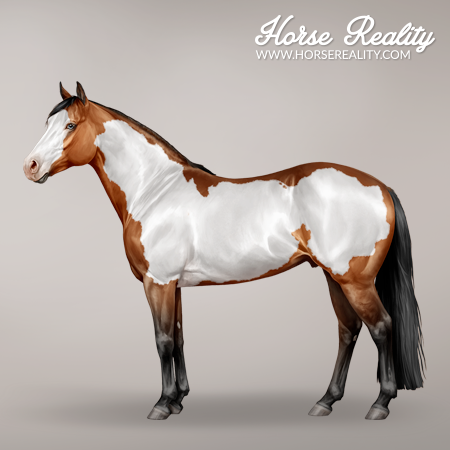
(E/_ A/_ OLW/n) |
Summary: Frame overo (OLW) is a dominant mutation. White patterns caused by frame show a horizontal direction - legs are usually coloured and white patches rarely cross the topline. Homozygous frame (OLW/OLW) causes the Overo Lethal White Syndrome.
¶ Leopard Complex
Leopard complex is a group of related white patterns. The most important characteristics are mottled skin, stripped hooves and white sclera. Many different leopard complex patterns show white patches, with or without pigmented spots known as leopard spots, and “roaning” (progressive loss of pigment with age). Even though they are present in several different breeds, the patterns are also often called "appaloosa" or “appaloosa spotting".
The LP allele of the leopard complex gene is the core of all leopard spotting patterns. Without any copies of LP, a horse won't have a leopard complex pattern. It is incomplete dominant; homozygous horses will have little to no leopard spots, while heterozygous horses usually do have leopard spots.
The test for leopard complex in Horse Reality can be found in the WHITE PATTERNS tab. There, it is named “appaloosa”.
Horses that are homozygous and heterozygous for the LP-allele will both vary in the amount of white area that is present, as this is controlled by different genes. These genes are called modifier genes. In-game, the pattern-1 (PATN1) and hidden pattern-2 (PATN2) modifiers are present. Pattern-1 can be found in the WHITE PATTERNS tab. The 3 genes work together to create a wide variety of patterns.
The exact genetics causing the patterns are not yet fully understood in real life. Pattern-2 is not a testable gene in real life but has been implemented in the game as a way to account for the unknown genetic causes of certain patterns. It may be the reason why a horse that tests negative for PATN1, still shows a spotted blanket or snowcap blanket pattern.
| Leopard Complex white patterns - Knabstrupper | ||

LP/_ patn1/patn1 |
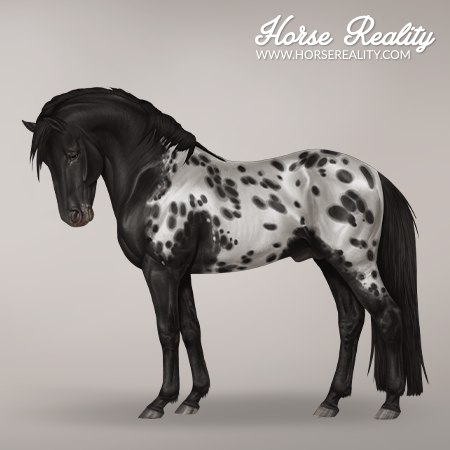
LP/lp PATN1/patn1 |
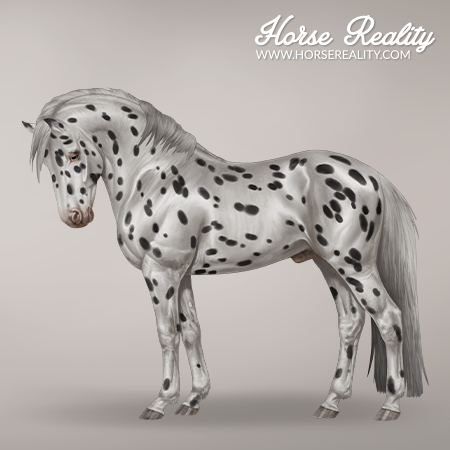
LP/lp PATN1/PATN1 |
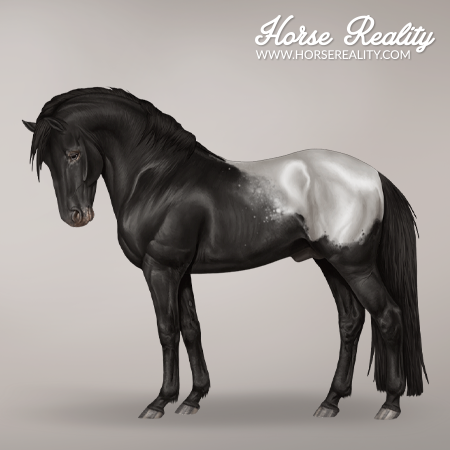
LP/LP PATN1/patn1 |
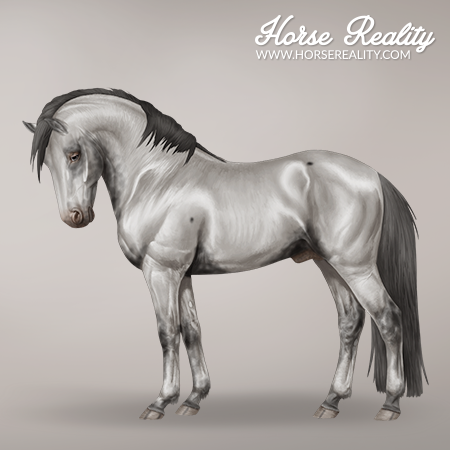
LP/LP PATN1/PATN1 |
|
Summary: The leopard complex (LP) gene and its modifiers pattern-1 (PATN1) and pattern-2 (PATN2) work together to create a variety of patterns. important characteristics are mottled skin, stripped hooves and white sclera. There are many different leopard complex patterns that show white patches, with or without pigmented spots known as leopard spots, and “roaning”.
¶ Splashed White 1
Splashed white is a name for a group of incomplete dominant mutations located on the MITF and PAX3 loci, that create a very similar pattern. Currently, only splashed white 1 (SW1) is implemented in the game. Several other splashed white mutations are testable, but not present in-game. Splashed white 1 causes white markings on the legs, belly, and head. Blue or partially blue eyes are very common. The expression of splashed white can vary from very minimal to extensive amounts of white. Edges between white and coloured areas are sharp. Homozygous splashed white 1 (SW1/SW1) creates more white than heterozygous splashed white.
The test for splashed white 1 in Horse Reality can be found in the WHITE PATTERNS tab, under the “MITF” gene.
| Splashed white 1 white pattern - Quarter Horse | ||
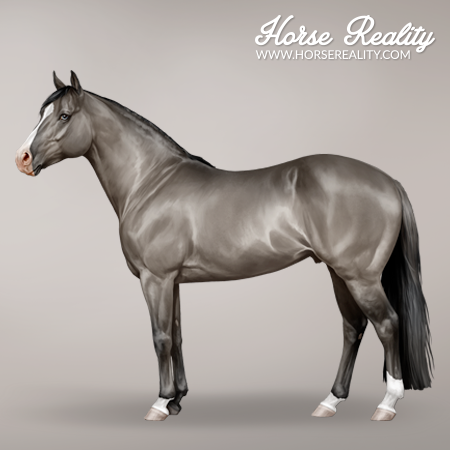
(SW1/n) |

(SW1/n) |

(SW1/SW1) |
Summary: Splashed white 1 (SW1) is an incomplete dominant mutation that creates white markings on the legs, belly, and head. Blue eyes may also be present.
¶ Tobiano
Tobiano (TO) is a dominant mutation located very close to the KIT locus. It causes white legs below the hocks and knees. In minimally expressed tobianos, this can be the only white they have. Tobiano has a rather vertical expression. Tobiano horses can also be characterised by white, rounded patches on the coat that typically cross the topline (back) of the horse somewhere between the ears and tail. It generally doesn't create markings on the head. Small, coloured spots within the white patches called paw prints, ink spots, or cat tracks are typical for horses homozygous for tobiano (TO/TO), but exceptions are possible.
The test for tobiano in Horse Reality can be found in the WHITE PATTERNS tab, under the “KIT” gene.
| Tobiano white pattern - Irish Cob Horse | ||

(E/_ A/_ TO/n) |
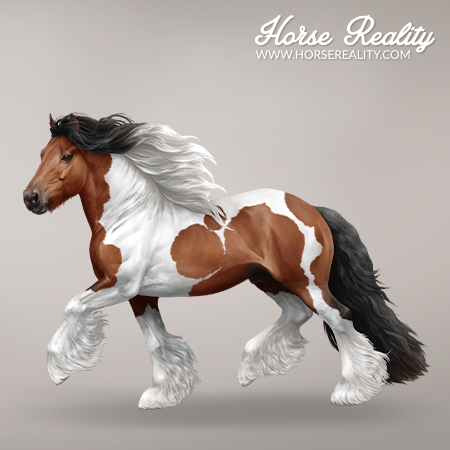
(E/_ A/_ TO/n) |
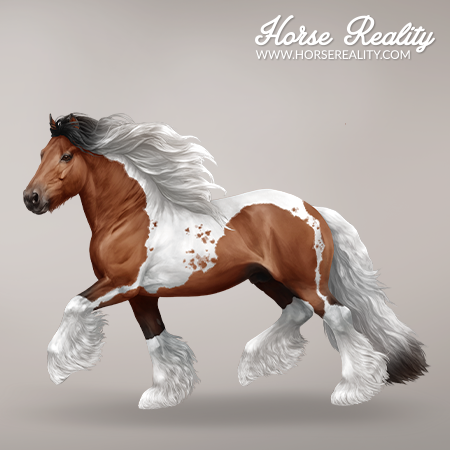
(E/_ A/_ TO/TO) |
Summary: Tobiano (TO) is a dominant mutation close to the KIT locus. Tobiano has a rather vertical expression, creating white legs and often crossing the topline of the horse, but not creating any markings on the head.
¶ Sabino 1
Sabino 1 (SB1) is an incomplete dominant mutation located at the KIT locus. It causes white markings on the legs, often accompanied by white patches, typically with irregular and jagged edges, on the horse's belly, face and/or entire body. White ticking on the body is also very common. There is a high variability of expression: it can be very minimal, or cause the horse to look almost entirely “white”. The nearly white phenotype is usually the result of homozygous sabino1 (SB1/SB1).
The test for sabino1 in Horse Reality can be found in the WHITE PATTERNS tab, under the “KIT” gene.
| Sabino1 white pattern - Irish Cob Horse | |

(SB1/n) |
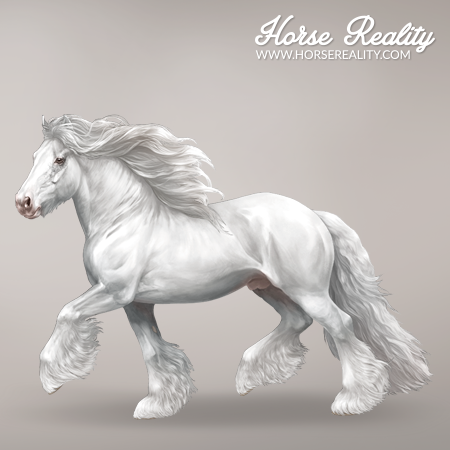
(ESB1/SB1) |
Summary: Sabino 1 (SB1) is an incomplete dominant mutation located at the KIT locus. Homozygous sabino 1 (SB1/SB1) usually creates a nearly white phenotype.
¶ Roan
Roan (RN) is a dominant mutation located at the KIT locus. It is characterised by white hairs mixed into the rest of the coat except for the head, lower legs, mane, and tail, which usually stay entirely coloured. The coloured head and the “inverted V's” on the legs are important characteristics of the roan: Where the roan meets the coloured lower legs, an upside-down-V-shaped border can be seen. When the skin of the roan body gets injured, the new hair that grows back as it heals will usually be coloured. These dark areas are often called corn spots or corn marks. Foals are born with the coat colour determined by their genes, without white hairs. In Horse Reality, horses will show a roan coat once they turn into an adult (3 years old).
The test for roan in Horse Reality can be found in the WHITE PATTERNS tab, under the “KIT” gene.
| Roan white pattern - Various breeds | |

(RN/_) |

(RN/_) |
Summary: Roan (RN) is a dominant mutation located at the KIT locus. Roan horses have white hairs mixed into the coat except for the head, lower legs, mane and tail.
¶ White Spotting
White spotting (W) mutations are located at the KIT locus. Currently, 34 different variations of white spotting (W1-W34) have been discovered in real life. At the moment, only W3 (Arabian Horse), W10 (Quarter Horse), W19, (Arabian Horse), W20 (Lipizzaner Horse) and W21 (Icelandic Horse) have been implemented in-game.
There is a large variability in the type of pattern and amount of white caused by each of the different variations. The expression may vary from leg and face markings with or without white patches on the belly, to even a nearly “white” phenotype. The white markings and patches often have irregular, jagged edges. White ticking on the body is also quite common.
In Horse Reality, only W20 is viable when homozygous (W20/W20) any other homozygous white spotting (Wx/Wx) combination is embryonic lethal and will lead to a failed covering. By now there is proof that certain white spotting combinations are viable when homozygous, but at the time of implementation, this was not yet known.
The tests for white spotting patterns in Horse Reality can be found in the WHITE PATTERNS tab, under the “KIT” gene.
| White Spotting white patterns - Various breeds | |

|
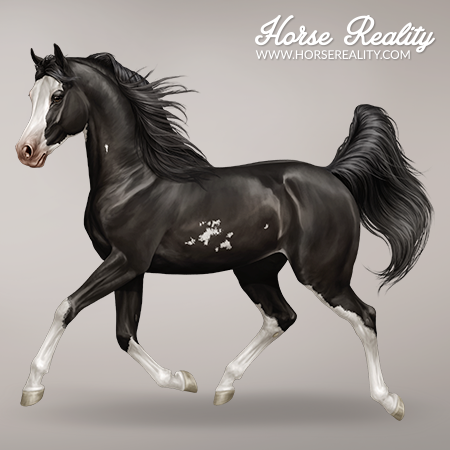
|
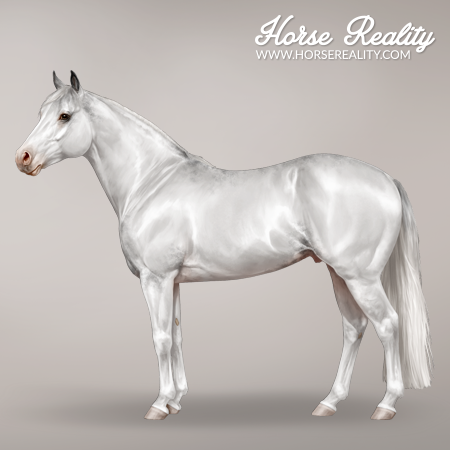
|
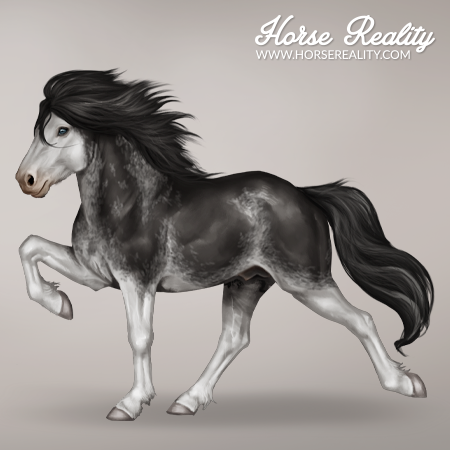
|
Summary: White spotting (W) mutations are located at the KIT locus. In Horse Reality, 5 white spotting alleles have been implemented: W3, W10, W19, W20 W21. Only W20/W20 is viable, any other homozygous white spotting (W/W) combination is embryonic lethal and will lead to a failed covering.
¶ Rabicano
Rabicano (rab) is caused by the recessive allele of a hidden gene. This means that rabicano only shows when a horse has 2 copies (rab/rab). Rabicano horses have white hairs at the base of their tail, which is often called a coon or skunk tail. The top of the tail itself may have white hairs mixed into it. Rabicano also causes white ticking concentrated around the flank area. The white ticking typically aligns itself in a vertical striping pattern on the sides of the horses. The expression of rabicano can vary strongly between horses. Some horses may only have a couple of white hairs in their tail, while other horses may have white ticking that covers almost their entire body.
| Rabicano white pattern - Arabian Horse | |
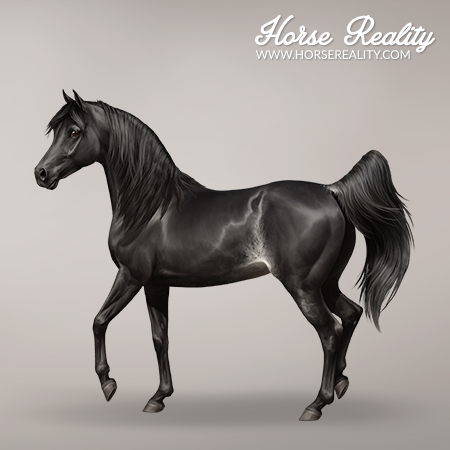
|

|

|

|
Summary: Rabicano (rab) is a recessive, hidden allele that causes white hairs at the base of the tail and white ticking on the flank area of the horse.
¶ Hidden Sabino
Hidden sabino is a hidden gene in Horse Reality that causes sabino1 or white spotting-like patterns, for which the genetic cause hasn't been found yet. The allele of this gene that is responsible for the hidden sabino phenotype is recessive. The expression of hidden sabino may vary between breeds, since it covers several untestable patterns in different breeds. The pattern can be very minimal and hard to distinguish from regular white markings or cause very extensive white. The expression of hidden sabino is also affected by the presence of other genes. This may cause some horses with hidden sabino to have very little white, while others have a very expressive pattern. Typical characteristics are (leg) markings that have irregular edges, belly spots, white ticking on the body, and face markings that go over the lower lip and/or jaw of the horse.
| Hidden Sabino white pattern - Various breeds | |

|
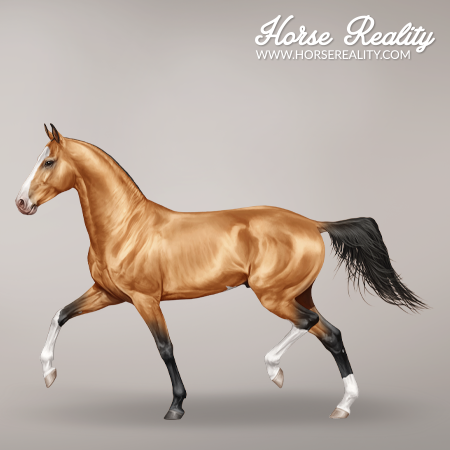
|
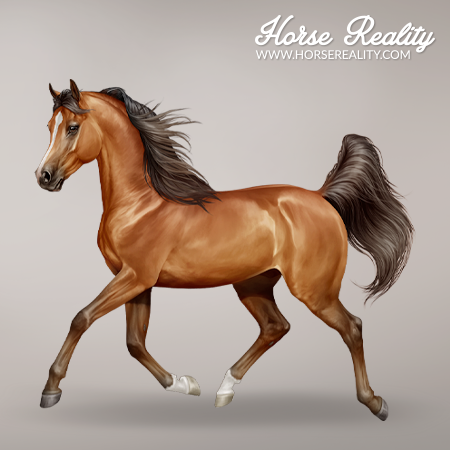
|
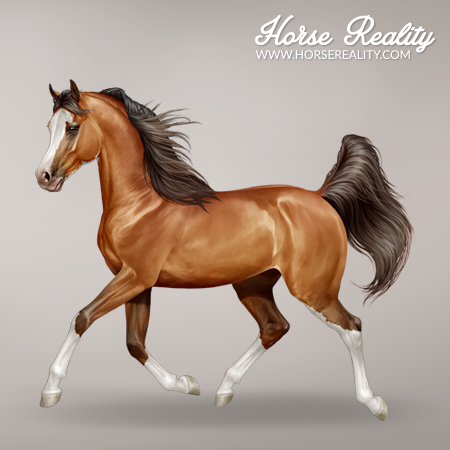
|
Summary: Hidden sabino is a recessive trait that causes sabino1 or white spotting-like patterns. The expression depends on the presence of other genes and may differ between breeds.
¶ White Markings
White markings are white areas of hair on the face, legs and/or body of the horse, not caused by any of the currently identified white patterns. In-game, white markings are caused by the alleles of the hidden WM gene. Which combination of WM-alleles a horse has, will determine the amount or size of their white markings; for example, whether they only have one small sock or high stockings on all four legs. Certain combinations of WM alleles may also affect the expression of other white patterns.
| White Markings - Akhal-Teke Horse | |

|
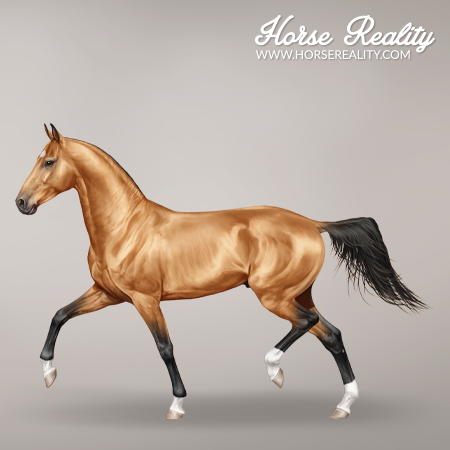
|
Summary: White markings are white areas on the horse not caused by any white patterns. The amount and size of white markings is determined by the combination of WM-alleles a horse has.
¶ A Big Thanks From the Team
We would like to thank our players Rikutsu, Ethena_Equus & Arctictea for the hard work put into the first thorough colour genetics guide in Horse Reality. Many players said it was really helpful in the original topic. We, from the Horse Reality Team, thought it would be amazing to put such valuable information in a more prominent place. Thus, we created this guide, inspired by the original topic so that any player can access it even more easily. Thank you so much for your awesome contributions <3
¶ References
- Bellone R., Sponenberg D. P., Equine Color Genetics, 4th Edition, 2017, Wiley-Blackwell
- Bowling A, Ruvinsky A., 2000, The Genetics of the Horse, 2000
- UC Davis Veterinary Genetics Laboratory; https://vgl.ucdavis.edu/; Access: December 2022
- Generatio Center for Animal Genetics; https://generatio.de/en/services/dna-tests-horses; Access: December 2022
- The University of Sydney, Online Mendelian Inheritance in Animals (OMIA); https://omia.org/OMIA000209/9796/; Access: December 2022